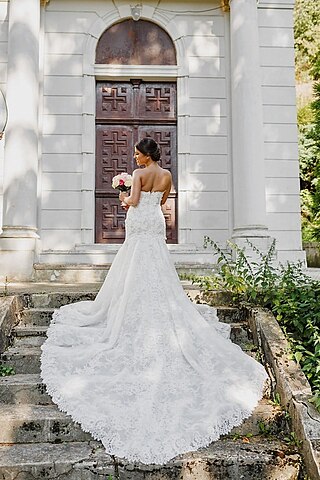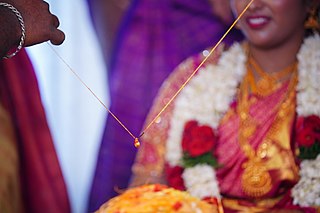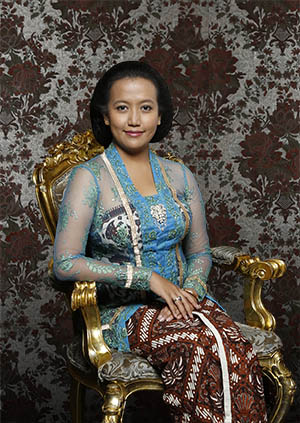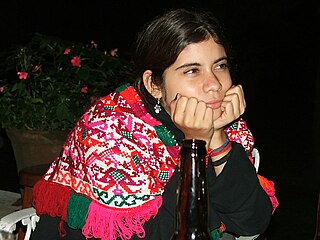
A wedding is a ceremony in which two people are united in marriage. Wedding traditions and customs vary greatly between cultures, ethnicities, races, religions, denominations, countries, social classes, and sexual orientations. Most wedding ceremonies involve an exchange of marriage vows by a couple; a presentation of a gift ; and a public proclamation of marriage by an authority figure or celebrant. Special wedding garments are often worn, and the ceremony is sometimes followed by a wedding reception. Music, poetry, prayers, or readings from religious texts or literature are also commonly incorporated into the ceremony, as well as superstitious customs.

A wedding ring or wedding band is a finger ring that indicates that its wearer is married. It is usually forged from metal, traditionally gold or another precious metal. Rings were used in ancient Rome during marriage.

North Sumatra, also called North Sumatra Province, is a province of Indonesia located in the northern part of the island of Sumatra, just south of Aceh. Its capital and largest city is Medan on the east coast of the island. It is bordered by Aceh on the northwest and Riau and West Sumatra on the southeast, by coastlines located on the Indian Ocean to the west, and by the Strait of Malacca to the east.

Lampung, officially the Province of Lampung, is a province of Indonesia. It is located on the southern tip of the island of Sumatra. It has a short border with the province of Bengkulu to the northwest, and a longer border with the province of South Sumatra to the north, as well as a maritime border with the provinces of Banten and Jakarta to the east. It is the home of the Lampung people, who speak their own language and possess their own written script. Its capital city is Bandar Lampung.

A wedding dress or bridal gown is the dress worn by the bride during a wedding ceremony. The color, style and ceremonial importance of the gown can depend on the religion and culture of the wedding participants. Wedding dresses hold a significant place in fashion, symbolizing personal expression, and cultural traditions and societal values. In Western culture, the wedding dress is most commonly white, a fashion made popular by Queen Victoria when she married in 1840. In Eastern cultures, brides often choose red to symbolize auspiciousness. These wedding dresses often represent a blend of heritage and contemporary trends, making them a pivotal aspect of bridal fashion and a reflection of evolving style in society.

Bandar Torkaman is a city in the Central District of Torkaman County, Golestan province, Iran, serving as capital of both the county and the district.

A mangala sutra, or tali, is a necklace that the groom ties around the bride's neck in the Indian subcontinent, in a ceremony called the Mangalya Dharanam during a Hindu wedding. The necklace serves as a visual marker of status as a married Hindu woman.

A kebaya is an upper garment traditionally worn by women in Southeast Asia, notably in Brunei, Indonesia, Malaysia, Singapore, and Southern Thailand. It is also worn in parts of southern Philippines and Cambodia.

The quechquemitl is a garment which has been worn by certain indigenous ethnicities in Mexico since the pre-Hispanic period. It usually consists of two pieces of rectangular cloth, often woven by hand, which is sewn together to form a poncho or shawl like garment, which is usually worn hanging off the shoulders. It can be constructed of various different fabrics, often with intricate weaves, and is typically highly decorated, most often with embroidery.

The wrapper, lappa, or pagne is a colorful garment widely worn in West Africa by both men and women. It has formal and informal versions and varies from simple draped clothing to fully tailored ensembles. The formality of the wrapper depends on the fabric used to create or design it.

Songket or sungkit is a tenun fabric that belongs to the brocade family of textiles of Brunei, Indonesia, and Malaysia. It is hand-woven in silk or cotton, and intricately patterned with gold or silver threads. The metallic threads stand out against the background cloth to create a shimmering effect. In the weaving process the metallic threads are inserted in between the silk or cotton weft (latitudinal) threads in a technique called supplementary weft weaving technique.

The traditional Vietnamese wedding is one of the most important ceremonies in Vietnamese culture, which is influenced by Confucian and Buddhist ideologies.
Pakistani clothing refers to the ethnic clothing that is typically worn by people in the country of Pakistan and by Pakistanis. Pakistani clothes express the culture of Pakistan, the demographics of Pakistan, and cultures from Punjab, Sindh, Balochistan, Khyber Pakhtunkhwa, Gilgit-Baltistan, and Kashmir regions of the country. The clothing in each region and culture of Pakistan reflect weather conditions, way of living, the textiles and embroidery used and its distinctive style which gives it a unique identity among all cultures.

Tapis is a traditional Tenun style and also refers to resulting cloth that originated from Lampung, Indonesia. It consists of a striped, naturally-coloured cloth embroidered with warped and couched gold thread. Traditionally using floral motifs, it has numerous variations. It is generally worn ceremonially, although it can be used as a decoration. It is considered one of the symbols of Lampung and Lampungese.
Bahaghara is a wedding ceremony performed by Odia Hindu people in the Indian state of Odisha. There are subtle differences in the rites observed by different castes. In Odia marriage rituals, the mother of the bridegroom does not take part in the ceremony. The Utkala Brahmins have their weddings only in the daytime, preferably at midday or in the morning, while the other caste weddings are done during the evening or night. There is the custom of sending betel nuts to family friends for inviting them to the marriage. The first invitation is sent to the family deity as a respect to the lord. Marriages in Odisha are mostly fixed and arranged by the parents. Marriages for serving or capturing is not common.

The national costume of Indonesia is the national attire that represents the Republic of Indonesia. It is derived from Indonesian culture and Indonesian traditional textile traditions. Today the most widely recognized Indonesian national attires include batik and kebaya, although originally those attires mainly belong within the island of Java and Bali, most prominently within Javanese, Sundanese and Balinese culture. Since Java has been the political and population center of Indonesia, folk attire from the island has become elevated into national status.

Balinese textiles are reflective of the historical traditions of Bali, Indonesia. Bali has been historically linked to the major courts of Java before the 10th century; and following the defeat of the Majapahit kingdom, many of the Javanese aristocracy fled to Bali and the traditions were continued. Bali therefore may be seen as a repository not only of its own arts but those of Java in the pre-Islamic 15th century. Any attempt to definitively describe Balinese textiles and their use is doomed to be incomplete. The use of textile is a living tradition and so is in constant change. It will also vary from one district to another. For the most part old cloth are not venerated for their age. New is much better. In the tropics cloth rapidly deteriorates and so virtue is generated by replacing them.

Geringsing is a Tenun textile created by the double ikat method in the Bali Aga village of Tenganan Pegeringsingan in Bali. The demanding technique is only practiced in parts of India, Japan and Indonesia. In Indonesia it is confined to the village of Tenganan.

Tortor is a traditional Batak dance originating from North Sumatra, Indonesia. This dance was originally a ritual and sacred dance performed at funerals, healing ceremonies, and other traditional Batak ceremonies. For the Batak people, tortor dance has both cultural and spiritual values. Through this dance, people express their hopes and prayers. Demonstrations of attitudes and feelings through this dance describe the situation and conditions that are being experienced.

Yoruba clothing is the traditional clothing worn by people of the Yoruba ethnic group in parts of Nigeria, Benin and Togo in a region called Yorubaland. The clothing reflects the rich culture, history and aesthetic preferences of the Yoruba people.



















